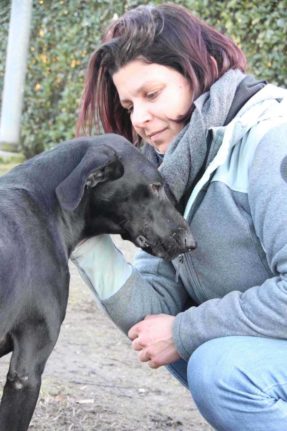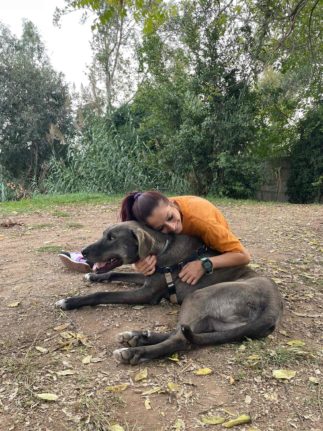Many people are open to the idea of adopting a rescue dog or cat, but may find the idea of doing so in a foreign country daunting.
While adopting a rescue animal in Italy involves some time and paperwork, in all it’s a fairly straightforward process.
Corinna Epifania has worked in animal rescue organisations in Italy for 35 years, founding the adoption charity Salva la Zampa (‘Save the Paw’) in Gaggiano near Milan in 2012.
Chiara Collatina volunteers at the Ponte Marconi public kennel in Rome, which is run and financed by city authorities. Last year she adopted her dog, Teo, from the shelter.
The Local spoke with Epifania and Collatina about how people in Italy can look into adopting a rescue pet, what the process involves, and how those who aren’t able to adopt can help in other ways.

The need for rescue pet adoption in Italy
The Italian animal rights group Lav estimates that around 80,000 dogs and 50,000 cats are abandoned each year in Italy, despite the act being punishable by or up to one year in prison or fines of €1,000-10,000.
The peak period for pet desertion is over the summer holidays, when around 25 to 30 percent of abandonments occur.
However a significant number of dogs are also abandoned in Italy during hunting season (around September-February), when owners get rid of hounds and gundogs that are too old to work.
Epifania says that Salva la Zampa has become known as a place that will take in ageing hunting dogs.
“With hunters we cannot have put them on a waiting list and say okay, now we don’t have the money to help you,” says Corinna, explaining the organisation fears that the dogs risk being shot in the meantime.
Salva la Zampa says that adoptions are down this year with the cost of living crisis, as people who might have considered taking in a rescue animal are instead prioritising basic necessities.
This means that while their ideal maximum capacity is 15 dogs, the organisation is currently caring for 25, pushing the organisation to its limits.
In the Ponte Marconi shelter, there are usually around 150 animals at any one time; as soon as one dog is adopted, a new rescue takes its place.
Unlike those at Salva la Zampa, most of the rescue animals in the public shelter are abandoned dogs found wandering the streets without collars or microchips.
Collatina says that she spent a year preparing to adopt Teo, then six years old, after he “stole my heart.”

“He is an exceptional dog; respectful, has never soiled the house or been naughty, is affectionate and adores children and elderly people,” she says.
“I don’t know his past, I only know that in his cage he was in pain and was very thin. Today he is a different dog: calm and very, very grateful.”
How to adopt
Wherever you live in Italy, you’re probably not far from an animal shelter; a simple search for a canile or rifugio per animali in your town or city should bring up multiple results.
You can browse profiles of the organisation’s animals first to see whether any of them seem like a good match, or just visit the shelter and meet the animals there (in most cases you’ll need to make an appointment).
When signing up to adopt, most reputable shelters will ask you to fill out a questionnaire asking for details about your living situation, household size and lifestyle, so they can identify the right dog or cat for you.
Epifania recommends always going through an organisation, as they will have built up a picture of the animal’s personality and history and can make sure the adoption stands the best chance of success.
In the past, for example, she says there have been cases of adoptions falling through when someone in, e.g., Milan takes in a stray dog from the south without considering whether a city apartment is the right place for them.
“I cannot give a very active dog to a couch potato, because the dog will get nervous and maybe destroy their house because he wants to do things,” says Epifania.
Similarly, “if I have an old person, I must give him a dog which he can take on the leash and walk without falling on the ground because the dog is pulling him down.”

Salva la Zampa is unusual in that a high proportion – around 80 percent – of its animals are adopted internationally by families in Germany, as well as Belgium, Holland, Austria, and Switzerland.
Epifania says she decided to branch into overseas adoptions due to the high number of pets needing a home in Italy and the shortfall in the number of people looking to adopt.
For these cross-border adoptions, the prospective owner is not required to visit the Gaggiano kennel in person, but one of the organisation’s partners on the ground will inspect their home to make sure it’s suitable.
It’s common for rescue organisations within Italy, too, to conduct checks on the home of the person taking in one of their animals, both in the weeks leading up to and following the adoption.
For in-country adoptions, Salva la Zampa requires candidates to come to the shelter in person at least once – sometimes multiple times – to build a rapport with their new pet. If the people adopting already have a dog, they’ll ask them to bring it to the shelter to see how the two animals get along.
Paperwork
All dogs in Italy must be microchipped and placed on the national canine registry as a legal requirement (for cats this is required only in certain regions); failure to do so could result in fines of up to several hundred euros.
READ ALSO: What you need to know about microchipping your pet in Italy
Dogs in shelters will have already been microchipped by a previous owner or the rescue organisation, but you’ll still need to submit a ‘passaggio di proprieta’ to register yourself as the new owner.
This requires both you and the shelter to sign a document that is then filed with the local public health authority (Azienda Sanitaria Locale, or Asl) confirming that both parties agree to the transfer of ownership.
Many shelters also require the new owner to sign a certificate of commitment promising to take good care of their pet for the rest of its life.
In some public shelters like Ponte Marconi, the official completion of the transfer is put on hold for 60 days in case the adoption breaks down and the animal is returned to the shelter. This is a last resort, and not a standard occurrence.

While the shelter will have given the animal a full health check, new owners will need to register their pet with a local vet and make sure they remain up to date with vaccines, passing on any medical information provided by the shelter.
International adoptions like those handled by Salva la Zampa require the preparation of an EU ‘pet passport’ that allows the animal to travel within the bloc.
The organisation then registers the transfer with the EU’s TRACES system, submitting the animal’s passport number and details, the name of the sending organisation, the address where it will be dropped off, the dates of travel and the estimated duration of the trip.
Adoption fees
Animal shelters in many European countries impose adoption fees, and the practice is now standard in Italy for those adopting from private shelters.
Salva la Zampa asks for an adoption free of no less than €200 from new owners in order to support the work of the organisation.
Publicly-run shelters, by contrast, won’t tend to request an adoption payment. Ponte Marconi does not ask for any fees, says Collatina.
How to help without adopting
If you’re not in a position to adopt, you can still be of great value to an organisation.
Volunteers are always in high demand in both public and private shelters.
“Obviously, the more volunteers there are, the more often the dogs have a chance to get out of their cages,” says Collatina.
Epifania says that Salva la Zampa is particularly keen to recruit young and/or tech savvy volunteers who can help with its social media accounts and raise awareness of the organisation’s work.
In terms of financial help, donors can assist private shelters like Salva la Zampa by donating through platforms like Wishraiser or Teaming, links to which can be found on its website.
Donors can also remotely ‘adopt’ a pet by paying a monthly sum for its food, shelter, and veterinary expenses. Sponsors who do this can visit ‘their’ dog in the shelter and take it for walks when they want.
Finally, taxpayers in Italy can donate money to an animal rescue charity by naming it as their ‘5 per mille’ (Italy’s Gift Aid equivalent) choice on their tax forms, meaning a small amount proportion of your tax money will go to them.
As a public shelter, Ponte Marconi doesn’t accept financial donations, but can receive blankets for the dogs.
Collatina says one of the main ways people can help is by both raising awareness of the need for adoption and dispelling myths about the types of dogs that are best to adopt.
“Often requests are made for puppies because people think it’s easier to train them or get them attached, but this isn’t true,” she says.
“You shouldn’t underestimate the power of adopting an adult or elderly dog; dogs that were raised in kennels and have never had a family, dogs that lived for years with the family they loved so much that then abandoned them, or dogs that grew up with violence and have never known love.”




 Please whitelist us to continue reading.
Please whitelist us to continue reading.
Member comments